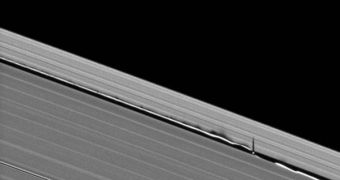Every now and then, the moons of Saturn align themselves in such a manner that they either throw their shadows on the surface of the planet, making them look like they're chasing each other, or they cast them on the giant planet's rings, creating vertical structures that are beautiful to look at. One such instance was recently pictured by the Cassini-Huygens spacecraft, currently making passes near Saturn and its moons. Orbiting in the planet's outer A ring, the eight-kilometer-wide moon Dephnis was found to be responsible for the vertical formations on the rings.
Despite the fact that astronomers believe they've discovered all of the planet's rings, it has been recently proven that this is not true. Over the last year, experts with the Cassini mission have discovered at least one moon, hidden within canals just kilometers across, inside dense regions of the dust rings. The International Astronomical Union (IAU) announced in March that another moon had been found in Saturn's G ring, and that the new body, which had not yet been named, was only a third of a mile in width. The moon is not important in itself, but because it orbits at a very peculiar point inside the rings.
According to the Cassini team, the new formations that were generated by Dephnis can be likened to “gravitational speed bumps” inside the rings. The height of the structure was accurately determined, as the space probe took advantage of the fact that the Sun was located at a perfect inclination from the plane of the rings. It stretched more than half a kilometer upwards, which means that it was 150 times as high as the rings were thick, ABC News reports. Saturn's rings are no more than ten meters thick.
“It's one thing to get data back that shows you're right about something, but to get pictures that are this stunning is really wonderful,” Space Science Institute Cassini researcher Dr. John Weiss, who is also the lead author of a paper detailing the formation Dephnis created, published in the latest issue of the Astronomical Journal, says. The researcher also highlights the fact that Cassini, from its vantage point some one million kilometers away from the formation, took advantage of a Sun-Saturn configuration that only occurred once every 15 years.
Over the next few months, while the Sun remains in this relative position, the team will continue its investigations of Saturn's rings, in hopes of finding even more peculiar formations such as this one. They say that some of the hidden moons, inside the rings, may be creating even more stranger formations than the last one found.

 14 DAY TRIAL //
14 DAY TRIAL //